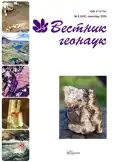No 9 (2024)
- Year: 2024
- Articles: 8
- URL: https://journal-vniispk.ru/2712-7761/issue/view/19661
Scientific articles
Kinetics of formation of individual C1-C5 hydrocarbons during stepwise dry pyrolysis of kerogen from Domanik shale after hydrothermal treatment
Abstract
The article presents the results of determining the kinetic characteristics of the formation of individual hydrocarbon gases at different stages of artificially increased thermal maturity of the Domanik shale from an Chut River outcrop (Ukhta District). Based on the data of stepwise pyrolysis of residual kerogen isolated from the shale after hydrothermal treatment, the distributions of the formation potential of individual hydrocarbons of the composition C1—C5 by the activation energy scale (kinetic spectra) were determined. The kinetic spectra of n-butane and n-pentane do not change with increasing temperature of the hydrothermal experiment and increasing maturity of the organic matter. The maximum of the potential distribution on the activation energy scale of methane and ethane shifts to the region of higher values with increasing thermal maturity. The results can be used to clarify the conditions for the implementation of the gas formation potential in the domanik deposits of the Timan-Pechora basin.
 3-11
3-11


The results of electron microscopic studies of the Lower Permian ooid dolomites (South Timan)
Abstract
The article presents the results of studies of the Lower Permian dolomites containing ooids. They outcrop in the northeastern part of the East European Platform and are confined to the upper-middle reaches of the Vychegda River (South Timan, near the mouth of the Nem River). Electron microscopic studies have revealed the complex structure of the dolomites conditioned by their heterogeneous nature. We found ooids, remains of microphytophossils (microphytoliths), and biomorphoses from various faunal remains. The results of the conducted research can be interpreted in different ways. On the one hand, traces of bacterial communities were found in the structure of zooids (oolites) from the studied rocks, indicating their biochemogenic nature. In this case, the microbiota, by changing the environment, could contribute to the deposition of protodolomite phases in the course of its vital activity. On the other hand, the dolomites contain mineral phases testifying to the multiphase formation of rocks.
 12-20
12-20


New data on stromatoporoidea of the Emsian age in the Polar Urals (Bolshaya Usa River)
Abstract
The results of the study of stromatoporoids of the Lower Devonian of the Polar Urals (Bolshaya Usa River) are presented. The data on the taxonomic composition of the Emsian stromatoproids of this area are supplemented. Species of Stellopora analoga Bogoyavl. and S. similis Bogoyavl. have been established here for the first time. The complex of stromatoporoids in combination with data on other fossil remains allows dating the studied interval of the section as the Late Emsian. The lithological composition and age of the studied section can be compared with the Early Devonian Shervozhskaya Formation.
 21-27
21-27


Mineralogical and technological assessment of waste from the Kuzbasskaya Central Processing Plant (Kemerovo region)
Abstract
The article deals with the results of the material composition studying of the Kuzbasskaya coal preparation plant waste. Such toxic elements as arsenic, chromium, mercury, selenium, beryllium and vanadium are included into the composition of this material. The valuable impurity elements are silver, lanthanum, molybdenum, scandium, selenium, lead and yttrium. The ash content of the original fuel was 22.4 %, which indicated the presence of non-combustible phases represented by inorganic matter. The optical and mineralogical analysis determined that this waste was composed of coal (82.51 %), in addition, it contained carbonates, feldspars, quartz, clay minerals, as well as magnetite and iron hydroxides. Sulfides, monazite, rutile, zircon and micas were visualized in single grains.
 28-34
28-34


Application of neural networks for chitinozoans recognition in images
Abstract
Paleontological identification of microfauna using automated image recognition represents an innovative practical application of existing software methods for analysis and classification based on computer vision and machine learning technologies. The development of software capable of recognition of Chitinozoans in images will simplify and speed up the processing of large amounts of microfossil data. The use of neural networks for image analysis is also possible for other groups of paleoorganics.
Chitinozoans have a number of advantages that allow a step-by-step assessment of the applicability of automated image recognition technology for biostratigraphic problems compared to other groups of microfossils. The artificial paleontological classification of Chitinozoa is based on clear morphological characteristics and can be formalized. At the first stage of solving recognition problems, a classification function was constructed that predicts class, the fossil belongs to, based on the input feature vector — either “chitinozoa” or “non-chitinozoa”. The developed model of the Сhitinozoans recognition algorithm showed a high degree of accuracy (more than 98 %).
 35-39
35-39


Application of neural networks for chitinozoans recognition in images
Abstract
Paleontological identification of microfauna using automated image recognition represents an innovative practical application of existing software methods for analysis and classification based on computer vision and machine learning technologies. The development of software capable of recognition of Chitinozoans in images will simplify and speed up the processing of large amounts of microfossil data. The use of neural networks for image analysis is also possible for other groups of paleoorganics.
Chitinozoans have a number of advantages that allow a step-by-step assessment of the applicability of automated image recognition technology for biostratigraphic problems compared to other groups of microfossils. The artificial paleontological classification of Chitinozoa is based on clear morphological characteristics and can be formalized. At the first stage of solving recognition problems, a classification function was constructed that predicts class, the fossil belongs to, based on the input feature vector — either “chitinozoa” or “non-chitinozoa”. The developed model of the Сhitinozoans recognition algorithm showed a high degree of accuracy (more than 98 %).
 35-39
35-39


Chronicle, events, facts. History of Science
Meeting of ore enrichment specialists in the scientific capital of the Kola Polar region (Plaksin Readings — 2024)
 40-42
40-42


In the memory of Vladimir Stepanovich Tsyganko (13.02.1938—28.09.2024)
 42-44
42-44










